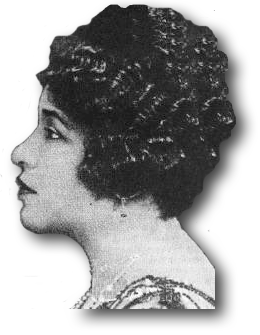 Lucille Hegamin was one of the bright stars of the Classic Blues era during
the 1920's. She was billed as the " Blues Singer Supreme ," "The Cameo
Girl," "Chicago Cyclone," "Georgia Peach" and "Harlem's Favorite." She
had a powerful voice combined with a strong and assured stage presence.
Lucille Hegamin was one of the bright stars of the Classic Blues era during
the 1920's. She was billed as the " Blues Singer Supreme ," "The Cameo
Girl," "Chicago Cyclone," "Georgia Peach" and "Harlem's Favorite." She
had a powerful voice combined with a strong and assured stage presence.Lucille was born in Macon, Georgia November 29, 1884 to John Nelson and Minnie Wallace. She was one of five children. Like so many others, she began singing in church and performing at local events around Macon while still a child. As her musical calling grew stronger, she traveled throughout the South with the Laurel Harper Minstrel Stock Company as a singer and entertainer.
Lucille made the move that so many African-American performers from the South have made by moving to Chicago around 1909. In 1914, she teamed with Bill Hegamin (who would later become her husband) and worked frequently at many cabarets and nightclubs. In 1918, she moved to New York City and within a year was a part of the HAPPY RHONE's ALL STAR SHOW.
She began recording in the early 1920's on the Victor label (unissued). In 1920, she formed the Blue Flame Syncopators Band (w/Bill Hegamin) and toured the vaudeville circuit throughout Pennsylvania, West Virginia and Ohio. In 1922, Lucille became a member of the cast of the extremely successful musical comedy SHUFFLE ALONG written by Noble Sissle and Eubie Blake.
Through the 1920's and early 1930's, Lucille continued to sing and perform in musical revues. She worked constantly and was in great demand. By 1933 and as the Great Depression took hold of the country, Lucille worked mostly outside of music as a registered nurse in New York City (Alberta Hunter also chose nursing as a profession after her first musical career). She did not give up music totally and continued to perform at special events. From 1934 through the 1950's, she recorded with Willie the Lion and his Clubs on the Bluesville label; 1961, recorded on the Spivey label in New York City; 1962, worked a Mamie Smith Benefit Concert at the Celebrity club also in in New York. As she grew older, her voice still remained strong. " She displayed a vigorous powerful voice, deep and resonant, youthful and exuberant. If anything, the passing years added conviction to her blues presentation", said Len Kunstadt in Nov. 1961's issue of RECORD RESEARCH magazine.
After 1964, Lucille did little performing due to illness. She died March 1, 1970.
"She was an extremely good singer of jazz and blues," states Derrick Stewart-Baxter form his book MA RAINEY AND THE CLASSIC BLUES SINGERS.
Like her Classic Blues sisters, Lucille Hegamin leaves to us the evidence of her gifts in her many recordings and a legacy of greatness.
To read more about Lucille Hegamin and the other Classic Blues singers, please read BLACK PEARLS written by Daphne Wilson. Ms. Hegamin's music is available in the larger music stores and on several historical anthologies.
Lea Gilmore